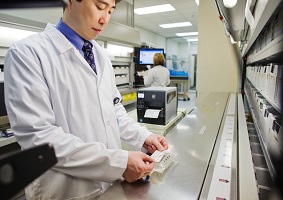Technology can, on occasion, be hyped. Gartner even has a methodology for it: The Hype Cycle. But when it comes to the hot topic of now, the Internet of Things (IOT), all talk’s justified: We believe that IOT will transform the way we work across many sectors, especially so in healthcare.
IOT describes an environment where smart labels (e.g. barcodes and RFID tags) and sensors fixed to objects, and linked to the internet, give those objects a digital voice. Sensors and barcodes can be attached to pretty much any item –clinicians, patients, vehicles, equipment, medicines and many more –and with these items transmitting streams of data (e.g. on their location), insight is provided over every corner of the hospital, in realtime.
We call this Visibility that’s Visionary. It allows us to rethink the way we work in healthcare.
BETTER WAYS OF WORKING
Many healthcare processes are based around manual workflows: workflows that involve paper records and manually entering data using keyboards. In high-pressure environments, this creates the scope for error and, with 98,000 deaths in the US alone attributed to medication errors, IOT offers safer and better ways of working. Here are three examples:
• Medication management: Take a nurse giving medication to a patient. At the patient’s bedside they can use a mobile computer to scan the patient’s ID bracelet. This will confirm the patient’s name (which the nurse can verify verbally) and bring up their medical record. The computer will provide a guided workflow with any instructions for administering the drug. The nurse can also scan the barcode on the drug packet to cross-check that the patient has no allergy to it. The computer is then used to confirm that the medication has been taken, with a note auto-created on the patient’s Electronic Health Record including the drug, time, date, and ID of the nurse.
• The critical hour: In critical cases time is of the essence. For example, with angioplasty surgery the goal might be to have the patient operated on within 60 minutes. By giving the patient a wristband with a barcode tag – which confirms their ID – the wristband can be scanned as the patient moves through treatment phases. If their progress slows, alarms can be automatically raised with senior clinicians who can intervene.
• Wrong Blood in Tube: Despite everyone’s best efforts, mistakes happen when taking blood in busy wards. By using mobile computers and printers, these critical errors can be avoided. Nurses can use mobile computers to view what tests are needed, scan a patient’s wristbands to confirm their ID, be guided through the blood collection process, and print barcode labels that are fixed to the sample. All of this takes place at the bedside, which we all know is vital to ensure that errors are avoided. The barcode ensures that the vial is always identified correctly and it can be tracked across the sample workflow – from the ward, to transit to the lab, and then into the lab itself.
There are many other ways that IOT will advance healthcare: from always knowing where your teams are in hospitals to ensure they can reach a critical patient quickly, to tracking every piece of equipment – everywhere, and holding the right amount of stock in your pharmacy – always.

DATA: THE CURRENCY OF IMPROVEMENT
IOT collects data from across your operations: data that can become the currency of improvement. Because, by using Big Data systems to uncover trends, you can continually revise workflows and even isolate ways to improve diagnosis, care, and treatment.
As we look forward, IOT is our number one prescription to advance the way our clinicians work,to support them with more intuitive technology, and, ultimately, to enhance patient care.